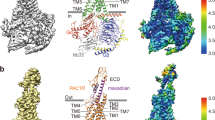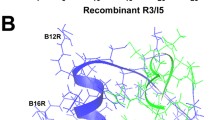Abstract
A potent and persistent non-mammalian derived vasodilator, maxadilan (Maxa) consists of 61 amino acids with two disulfide linkages and acts as an agonist of the type I receptor of pituitary adenylate cyclase activating polypeptide (PACAP), although there is very little sequence similarity. The total chemical syntheses of Maxa, its disulfide isomers and various fragments have been performed successfully by highly efficient solid-phase peptide synthesis (SPPS). A “difficult sequence”, envisaged in the middle region of Maxa, could be overcome by improved synthesis protocols. After assembly peptides were liberated from the resin by cleavage. Peptides having disulfide(s) were purified by two steps of preparative HPLC using cation exchange followed by reverse phase columns. Purified peptides were characterized by HPLC, Edman-sequencing, amino acid analysis and mass spectrometry in addition to disulfide form determination. The peptides obtained were used for recognition studies by the melanophore assay to confirm the native disulfide form. Peptide libraries related to Maxa, produced in the present study, will be useful for the elucidation of the structural requirements of Maxa for interaction with the PACAP type 1 receptor (PAC1).







Similar content being viewed by others
Abbreviations
- HATU:
-
N-[(dimethylamino)-1H-1,2,3-triazolo[4,5-b]pyridin-1-ylmethylene]-N- methylmethanaminium hexafluorophosphate N-oxide
- HOBt:
-
1-hydroxybenzotriazole
- LC-IT-MS:
-
liquid chromatograph with on-line ion-trap mass spectrometry
- MALDI-TOF MS:
-
matrix assisted laser desorption ionization time of flight mass spectrometry
- Maxa:
-
maxadilan
- PACAP:
-
pituitary adenylate cyclase activating polypeptide
- PAC1:
-
PACAP type 1 receptor
- SPPS:
-
solid-phase peptide synthesis
- RP-HPLC:
-
reverse-phase high performance liquid chromatography
- PyBOP:
-
benzotriazole-1-yl-oxy-tris(pyrrolidino)phosphonium hexafluorophosphate
- TFA:
-
trifluoroacetic acid
- TMP:
-
2,4,6-trimethylpyridine
References
Ando, E., Nokihara K., Naruse S., Wray V. (1996) Biomed. Pept. Proteins Nucleic Acids 2, 41–46
Bidlingmeyer B. A., Cohen S. A., Tarvin T. L. (1984) J. Chromat., 336, 93-104
Carpino, L. A., El-Faham, A., Minor, C. A., Albericio, F. J.: 1994, Chem. Soc., Chem. Commun., 201–203
Carpino L. A., El-Faham A.J. (1995) Org. Chem., 60, 3561–3564
Chang J -Y., Knecht R., Braun D. G. (1981) Biochem. J. 199, 544–555
Kimura, T.: 2004, in M. Goodman (Ed. in Chief) Houben-Weyl Methods of Organic Chemistry E22b, Georg Thieme Verlag, Stuttgart and New York, pp. 143
Lerner E. A., Ribeiro J. M. C., Nelson J. R., Lerner M. R. (1991) J. Biol. Chem. 262, 11234–11236
Lerner E. A., Shoemaker C. B. (1992) J Biol Chem. 267, 1062–1066
Lerner M. (1994) TINS 17, 142–146
Lowry O. H., Rosenbrough N. J., Farr A. L., Randall R. J. (1951) J. Biol. Chem. 193, 265–267
Miyata A., Arimura A., Dahl R.R., Minamino N., Uehara A., Jiang L., Culler M.D., Coy D.H. (1989) Biochem. Biophys. Res. Commun. 164, 567–574
Miyata A., Jiang L., Dahl R. D., Kitada C., Kubo K., Fujino M., Minamino N., Arimura A. (1990) Biochem. Biophys. Res. Commun. 170, 643–648
Moro O., Lerner E. A. (1997) J. Biol. Chem. 272, 966–970
Nokihara K., Semba T. (1988) J. Amer. Chem. Soc. 110, 7847–7854
Nokihara K. (1990) Peptides 11, 185–191
Nokihara K., Morita N., Yamaguchi M., Watanabe T. (1992) Anal. Lett. 25, 513–533
Nokihara K., Wray V., Ando E., Naruse S., Hayakawa T. (1997a) Reg. Peptides. 70, 111–120
Nokihara K., Nagawa Y., Hong S -P., Nakanishi H. (1997b) Lett Peptide Sci. 4, 141–146
Nokihara K., Naruse S., Ando E., Wei M., Ozaki T., Wray V. (1998 In Ramage R. (Ed), Peptides. Mayflower Scientific Ltd., Birmingham, UK, pp 63–66
Nokihara, K., Yasuhara, T., Nakata, Y. and Wray, V.: 2001a in R. Epton (Ed.), Solid-Phase Synthesis and Combinatorial Chemical Libraries 2000. Mayflower Scientific Ltd., Birmingham, UK, pp. 23–28
Nokihara K., Shimizu S., Pipkorn R., Yasuhara T., and Shioda T. (2001b) In Shioiri T. (Eds.), Peptide Science 2000: The Japanese Peptide Society, Osaka, pp 13–16
Pereira P., Reddy V. B., Kounga K., Bello Y., Lerner E. (2002) Pigment Cell Res. 15, 461–466
Qureshi A. A., Asahina A., Ohnuma M., Tajima M., Granstein R. D., Lerner E. A. (1996) Am J Trop Med Hyg. 54, 665-671
Rawlings S. R., Hezareh M. (1996) Endocrine Reviews. 17, 4–29
Wray V., Blankenfeldt W., Nokihara K., Naruse S. (1998) In Ramage, R. (Eds), Peptides, pp 921–922. Mayflower Scientific Ltd., Birmingham
Acknowledgments
The authors thank Professor T. Kasama, Tokyo Medical and Dental University for MALDI-TOF analyses. A part of the present study was supported by a grant from the Ministry of Education, Science, and Culture, Japan.
Author information
Authors and Affiliations
Corresponding author
Additional information
This paper is dedicated to the memory of Professor Bruce Merrifield, a pioneer and one of the most respected experimental scientists, who made extraordinary contributions to high throughput chemical synthesis.
Rights and permissions
About this article
Cite this article
Nokihara, K., Yasuhara, T., Nakata, Y. et al. Chemical Synthesis of Maxadilan, a Non-mammalian Potent Vasodilatory Peptide Consisting of 61 Amino Acids with Two Disulfide Bridges, and Its Related Peptides. Int J Pept Res Ther 13, 377–386 (2007). https://doi.org/10.1007/s10989-007-9097-9
Received:
Accepted:
Published:
Issue Date:
DOI: https://doi.org/10.1007/s10989-007-9097-9




